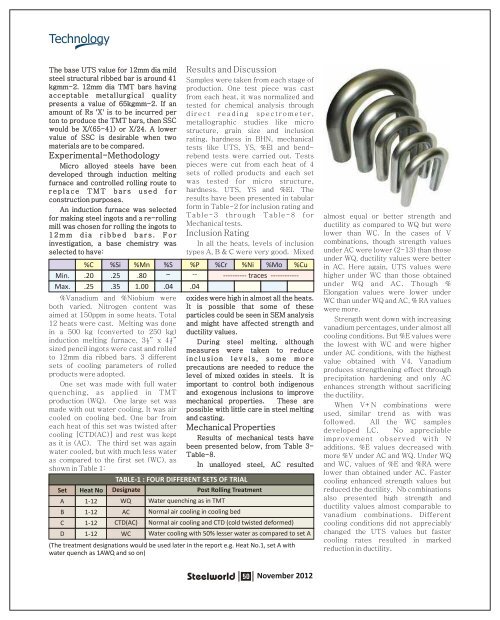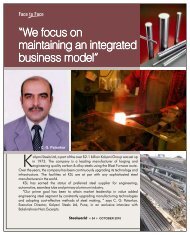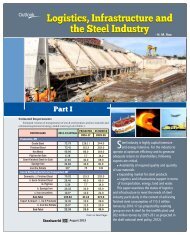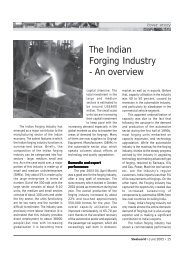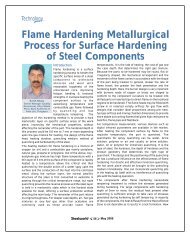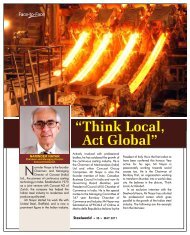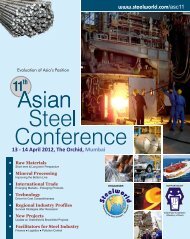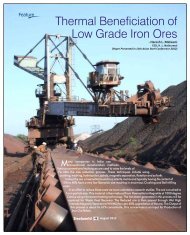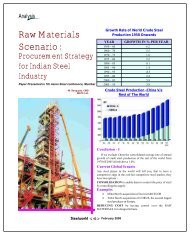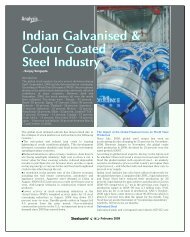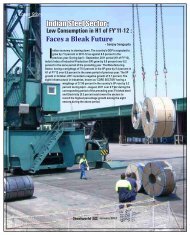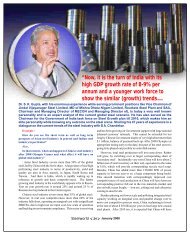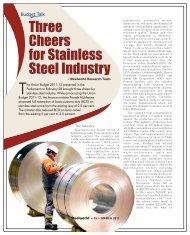Development of Micro Alloyed Structural Steels - Steelworld
Development of Micro Alloyed Structural Steels - Steelworld
Development of Micro Alloyed Structural Steels - Steelworld
Create successful ePaper yourself
Turn your PDF publications into a flip-book with our unique Google optimized e-Paper software.
Technology<br />
The base UTS value for 12mm dia mild<br />
steel structural ribbed bar is around 41<br />
kgmm-2. 12mm dia TMT bars having<br />
acceptable metallurgical quality<br />
presents a value <strong>of</strong> 65kgmm-2. If an<br />
amount <strong>of</strong> Rs 'X' is to be incurred per<br />
ton to produce the TMT bars, then SSC<br />
would be X/(65-41) or X/24. A lower<br />
value <strong>of</strong> SSC is desirable when two<br />
materials are to be compared.<br />
Experimental-Methodology<br />
<strong>Micro</strong> alloyed steels have been<br />
developed through induction melting<br />
furnace and controlled rolling route to<br />
r e p l a c e T M T b a r s u s e d f o r<br />
construction purposes.<br />
An induction furnace was selected<br />
for making steel ingots and a re-rolling<br />
mill was chosen for rolling the ingots to<br />
1 2 m m d i a r i b b e d b a r s . F o r<br />
investigation, a base chemistry was<br />
selected to have:<br />
%C %Si %Mn %S %P %Cr %Ni %Mo %Cu<br />
Min. .20 .25 .80 – -- ---------- traces ------------<br />
Max. .25 .35 1.00 .04 .04<br />
%Vanadium and %Niobium were<br />
both varied. Nitrogen content was<br />
aimed at 150ppm in some heats. Total<br />
12 heats were cast. Melting was done<br />
in a 500 kg (converted to 250 kg)<br />
induction melting furnace, 3½” x 4½”<br />
sized pencil ingots were cast and rolled<br />
to 12mm dia ribbed bars. 3 different<br />
sets <strong>of</strong> cooling parameters <strong>of</strong> rolled<br />
products were adopted.<br />
One set was made with full water<br />
quenching, as applied in TMT<br />
production (WQ). One large set was<br />
made with out water cooling. It was air<br />
cooled on cooling bed. One bar from<br />
each heat <strong>of</strong> this set was twisted after<br />
cooling [CTD(AC)] and rest was kept<br />
as it is (AC). The third set was again<br />
water cooled, but with much less water<br />
as compared to the first set (WC), as<br />
shown in Table 1:<br />
Set<br />
A<br />
B<br />
C<br />
D<br />
Heat No<br />
1-12<br />
1-12<br />
1-12<br />
1-12<br />
TABLE-1 : FOUR DIFFERENT SETS OF TRIAL<br />
Designate<br />
Post Rolling Treatment<br />
WQ<br />
AC<br />
CTD(AC)<br />
WC<br />
Results and Discussion<br />
Samples were taken from each stage <strong>of</strong><br />
production. One test piece was cast<br />
from each heat, it was normalized and<br />
tested for chemical analysis through<br />
d i r e c t r e a d i n g s p e c t r o m e t e r ,<br />
metallographic studies like micro<br />
structure, grain size and inclusion<br />
rating, hardness in BHN, mechanical<br />
tests like UTS, YS, %El and bendrebend<br />
tests were carried out. Tests<br />
pieces were cut from each heat <strong>of</strong> 4<br />
sets <strong>of</strong> rolled products and each set<br />
was tested for micro structure,<br />
hardness. UTS, YS and %El. The<br />
results have been presented in tabular<br />
form in Table-2 for inclusion rating and<br />
Table-3 through Table-8 for<br />
Mechanical tests.<br />
Inclusion Rating<br />
In all the heats, levels <strong>of</strong> inclusion<br />
types A, B & C were very good. Mixed<br />
oxides were high in almost all the heats.<br />
It is possible that some <strong>of</strong> these<br />
particles could be seen in SEM analysis<br />
and might have affected strength and<br />
ductility values.<br />
During steel melting, although<br />
measures were taken to reduce<br />
i n c l u s i o n l e v e l s , s o m e m o r e<br />
precautions are needed to reduce the<br />
level <strong>of</strong> mixed oxides in steels. It is<br />
important to control both indigenous<br />
and exogenous inclusions to improve<br />
mechanical properties. These are<br />
possible with little care in steel melting<br />
and casting.<br />
Mechanical Properties<br />
Results <strong>of</strong> mechanical tests have<br />
been presented below, from Table 3-<br />
Table-8.<br />
In unalloyed steel, AC resulted<br />
Water quenching as in TMT<br />
Normal air cooling in cooling bed<br />
Normal air cooling and CTD (cold twisted deformed)<br />
Water cooling with 50% lesser water as compared to set A<br />
(The treatment designations would be used later in the report e.g. Heat No.1, set A with<br />
water quench as 1AWQ and so on)<br />
almost equal or better strength and<br />
ductility as compared to WQ but were<br />
lower than WC. In the cases <strong>of</strong> V<br />
combinations, though strength values<br />
under AC were lower (2-13) than those<br />
under WQ, ductility values were better<br />
in AC. Here again, UTS values were<br />
higher under WC than those obtained<br />
under WQ and AC. Though %<br />
Elongation values were lower under<br />
WC than under WQ and AC, % RA values<br />
were more.<br />
Strength went down with increasing<br />
vanadium percentages, under almost all<br />
cooling conditions. But %E values were<br />
the lowest with WC and were higher<br />
under AC conditions, with the highest<br />
value obtained with V4. Vanadium<br />
produces strengthening effect through<br />
precipitation hardening and only AC<br />
enhances strength without sacrificing<br />
the ductility.<br />
When V+N combinations were<br />
used, similar trend as with was<br />
followed. All the WC samples<br />
developed LC. No appreciable<br />
improvement observed with N<br />
additions. %E values decreased with<br />
more %V under AC and WQ. Under WQ<br />
and WC, values <strong>of</strong> %E and %RA were<br />
lower than obtained under AC. Faster<br />
cooling enhanced strength values but<br />
reduced the ductility. Nb combinations<br />
also presented high strength and<br />
ductility values almost comparable to<br />
vanadium combinations. Different<br />
cooling conditions did not appreciably<br />
changed the UTS values but faster<br />
cooling rates resulted in marked<br />
reduction in ductility.<br />
50<br />
November 2012


